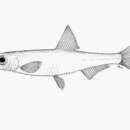Diagnostic Description
(
anglais
)
fourni par Fishbase
Diagnosis: Body slender, depth about 20% of standard length; scutes beginning at isthmus, or just behind, very strongly keeled, 12-15 pre-pelvic and 6-8 post-pelvic scutes; lower jaw projecting, toothless; no teeth on premaxillae or maxillae; posterior supra-maxilla as deep as maxilla blade and with long slender anterior shaft; lower gill rakers 24-31; pelvic fin with 1 unbranched and 6-7 branched rays, its insertion just before dorsal fin origin; anal fin rays 20-23; scales in lateral series 35-40 (Ref. 188, 2263). It differs from Nannothrissa stewarti in having more gillrakers, 24-31 vs. 20-23, more anal fin rays, 20-23 vs. 17-19, and more scales in lateral series, 35-40 vs. 34-35 (Ref. 188, 2263, 94752).Description: Depth of body 4 to 5 times in its length; caudal peduncle longer than deep (Ref. 2263). Snout a little shorter than diameter of eye, which is rather more than 1/3 the length of head; lower jaw a little projecting, toothless; no teeth on pre-maxillary and maxillary; maxillary extending to vertical from anterior edge of eye; posterior supra-maxilla half as long as maxilla (Ref. 188, 2263, 93833). Lower gillrakers 24-31 (Ref. 188, 93833). Dorsal fin with 12-15 rays; anal fin with 20-23 rays; pectoral fin with 11-12 rays; pelvic fin with 1 unbranched and 6-7 branched rays, its insertion about half eye diameter before dorsal fin origin; caudal fin with 18-19 rays (Ref. 188, 2263, 93833, 94751). Scales: 35-42 in a longitudinal series (Ref. 188, 2263, 93833, 94751). Scutes very strongly keeled, beginning at isthmus or just behind; 12-15 pre-pelvic and 6-8 post-pelvic scutes (Ref. 188, 2263). Number of vertebrae 39-40 (Ref. 94751).Colouration: More or less transparent, entirely silvery with pearly blue-green and pink reflections; dorsal region slightly darker; top of head, tip of snout and chin black; eye black; ventral scutes and base of impaired fins blackish; ventral and anal fins transparent, pectoral and dorsal fins slightly darkened, lobes of caudal fin blackish; a weak black band on the caudal peduncle, widening towards the base of the latter, and clearly visible in preserved specimens (Ref. 41580).
- licence
- cc-by-nc
- droit d’auteur
- FishBase
- Recorder
- Crispina B. Binohlan
Morphology
(
anglais
)
fourni par Fishbase
Dorsal spines (total): 0; Dorsal soft rays (total): 12 - 15; Analspines: 0; Analsoft rays: 20 - 23; Vertebrae: 39 - 40
- licence
- cc-by-nc
- droit d’auteur
- FishBase
- Recorder
- Crispina B. Binohlan
Trophic Strategy
(
anglais
)
fourni par Fishbase
Found in rivers and lakes, apparently in both running and still water, often in huge schools (Ref. 188). Feeds on plankton, including unicellular algae, diatoms and especially copepods, but also hydracarians and aquatic insects (Ref. 188, 41580).
- licence
- cc-by-nc
- droit d’auteur
- FishBase
- Recorder
- Crispina B. Binohlan
Biology
(
anglais
)
fourni par Fishbase
Found in rivers and lakes, apparently in both running and still water, often in huge schools (Ref. 188). Feeds on plankton, including unicellular algae, diatoms and especially copepods, but also hydracarians and aquatic insects (Ref. 188, 41580). It breeds in Lake Tumba, ripe fishes being caught in late August and ripe and some spent fishes occurring in about mid-September (Ref. 188, 41580).
- licence
- cc-by-nc
- droit d’auteur
- FishBase
- Recorder
- Crispina B. Binohlan
Importance
(
anglais
)
fourni par Fishbase
fisheries: subsistence fisheries
- licence
- cc-by-nc
- droit d’auteur
- FishBase
- Recorder
- Crispina B. Binohlan
Nannothrissa parva: Brief Summary
(
catalan ; valencien
)
fourni par wikipedia CA
Nannothrissa parva és una espècie de peix pertanyent a la família dels clupèids.
- licence
- cc-by-sa-3.0
- droit d’auteur
- Autors i editors de Wikipedia
Nannothrissa parva
(
basque
)
fourni par wikipedia EU
(RLQ=window.RLQ||[]).push(function(){mw.log.warn("Gadget "ErrefAurrebista" was not loaded. Please migrate it to use ResourceLoader. See u003Chttps://eu.wikipedia.org/wiki/Berezi:Gadgetaku003E.");});
- licence
- cc-by-sa-3.0
- droit d’auteur
- Wikipediako egileak eta editoreak
Nannothrissa parva: Brief Summary
(
basque
)
fourni par wikipedia EU
Nannothrissa parva Nannothrissa generoko animalia da. Arrainen barruko Clupeidae familian sailkatzen da.
- licence
- cc-by-sa-3.0
- droit d’auteur
- Wikipediako egileak eta editoreak
通巴湖細棱鯡
(
chinois
)
fourni par wikipedia 中文维基百科
通巴湖細棱鯡: Brief Summary
(
chinois
)
fourni par wikipedia 中文维基百科
通巴湖細棱鯡為輻鰭魚綱鲱形目鲱科的其中一種,分布於非洲剛果河流域的通巴湖,體長可達4.2公分,棲息在淡水溪流、湖泊,成群活動,以藻類、橈腳類為食,可做為食用魚。

